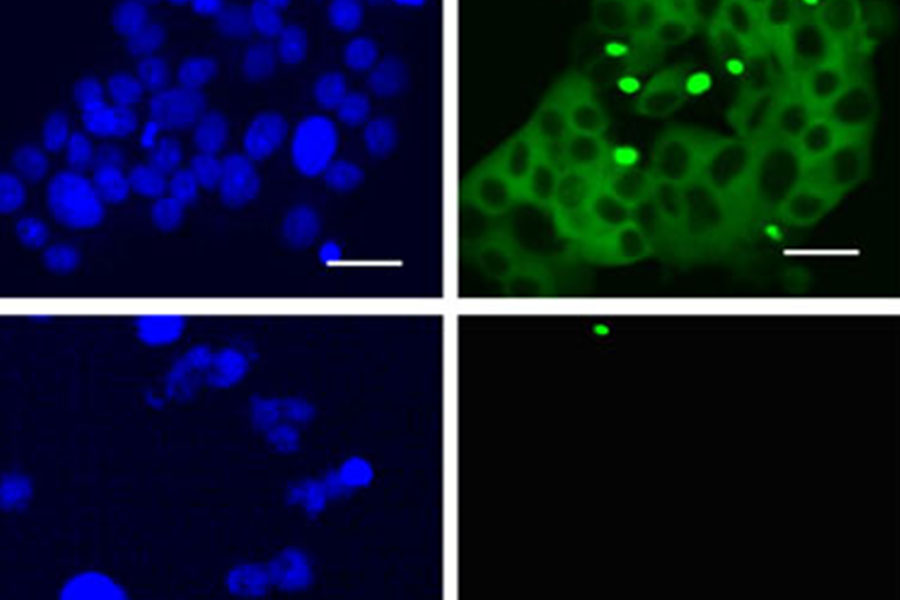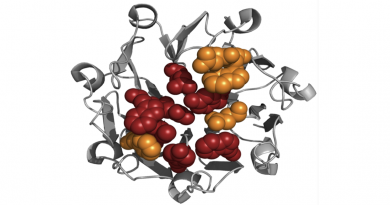A new approach to potentially treat Huntington’s disease

In Huntington’s disease, a single faulty gene called huntingtin causes a progressive breakdown of nerve cells in the brain and severe physical and neurological damage leading to death. There is no cure or treatments to prevent it. Early symptoms of Huntington’s disease, such as uncontrolled movements or difficulty focusing, typically begin in a person’s 30s or 40s. Over time, people with the disorder lose the ability to move, speak and think. About 30,000 people in the U.S. have the disease.
Scientists think that accumulation of high levels of the mutated protein huntingtin in cells plays a role in the neurodegeneration observed in Huntington’s disease. This accumulation seems to happen because of a breakdown in the cell’s ability to discard its cellular waste, a process called autophagy. In autophagy, damaged proteins and worn-out cellular components are delivered to the cell’s lysosome, a compartment where these components are broken down by enzymes and recycled. Cells can use this process to clear out the accumulation of disease-causing proteins, including those found in Huntington’s disease. In Huntington’s, which is one of nearly 50 human cellular waste storage disorders, autophagy is less effective than usual, leading to a toxic buildup of cellular waste.
Finding a way to improve poor cellular waste disposal function
In earlier work, Dr. Juan Marugan, acting branch chief and group leader of the National Center for Advancing Translational Sciences (NCATS) Chemical Genomics Center, and his NCATS colleagues tested thousands of compounds against toxic huntingtin in diseased cells. The team found that one compound, NCT-504, lowered the level of Huntington’s protein in the cells and improved the cells’ survival.
Marugan and his colleagues subsequently discovered that the compound worked by blocking PIP4Kgamma activity. To better understand how this related to Huntington’s disease, the NCATS group, including Dr. Marc Ferrer and Dr. Noel Southall, collaborated with Dr. Lois Weisman and her research team at the University of Michigan Life Sciences Institute in Ann Arbor.
The researchers knew that PIP4Kgamma plays a role in cell signaling, a process by which cells send chemical messages to communicate information for biological activities. The team used NCT-504 to inhibit PIP4Kgamma activity in various cells, including connective tissue cells from Huntington’s disease patients and human and mouse neurons from Huntington’s models. This inhibition of PIP4Kgamma increased recycling activity and reduced the clusters of Huntington’s proteins in the cells.

The researchers also wanted to see what would happen if they genetically turned off PIP4Kgamma activity. Dr. Juan Botas, professor of molecular and human genetics and of molecular and cellular biology at Baylor College of Medicine, and member of the Jan and Dan Duncan Neurological Research Institute and his colleagues studied two different Huntington’s models using fruit flies. The fruit fly model has been shown to mimic many of the effects of Huntington’s disease in humans. The neurons of Huntington’s fruit fly models are littered with toxic Huntington’s proteins.
Silencing PIP4Kgamma activity reduced the amount of Huntington’s disease protein that accumulated in fruit fly neurons, lessening the damage to the neurons and improving the flies’ ability to move.
“These results provide important insights into understanding the biology of a rare, devastating neurological disease,” said Marugan. “PIP4Kgamma inhibitors could be useful for Huntington’s and other neurodegenerative disorders such as Alzheimer’s and Parkinson’s diseases, which also are marked by the accumulation of toxic proteins.”
The researchers plan to continue to evaluate molecules that are more efficient at blocking the enzyme. “We want to develop better molecules that could intervene in Huntington’s and potentially other diseases,” Marugan said.
Read all the details of this work and the names of all the contributors and their affiliations in the journal eLife.
The research was supported by NCATS through its Intramural Research Program; National Institute of Neurological Disorders and Stroke grants R01-NS064015, R01-NS099340 and R01-NS097542 National Institute on Aging grant P30-AG053760; the American Heart Association; and the University of Michigan through its Protein Folding Diseases Initiative.
(Largely based on NCATS release)



